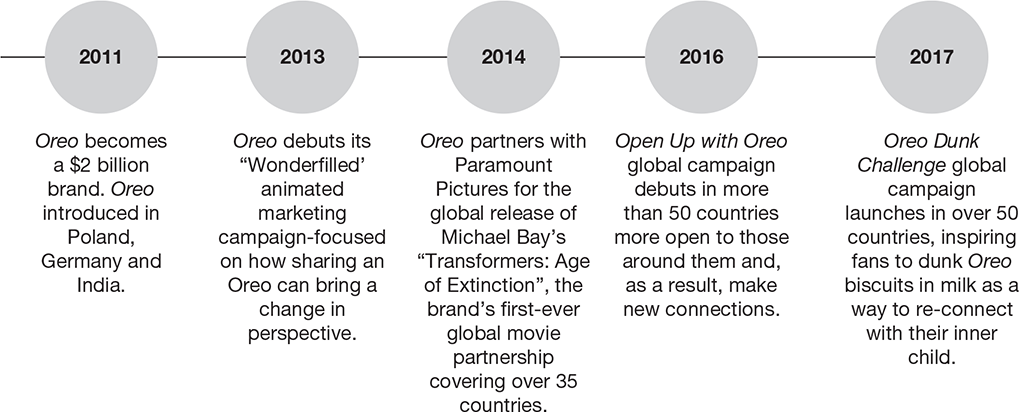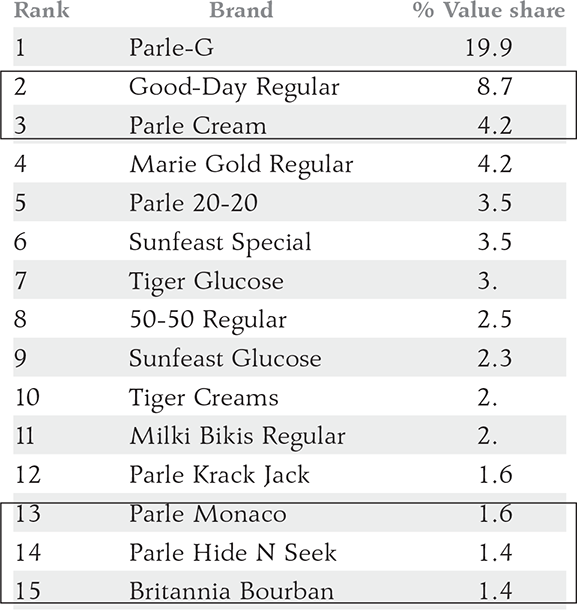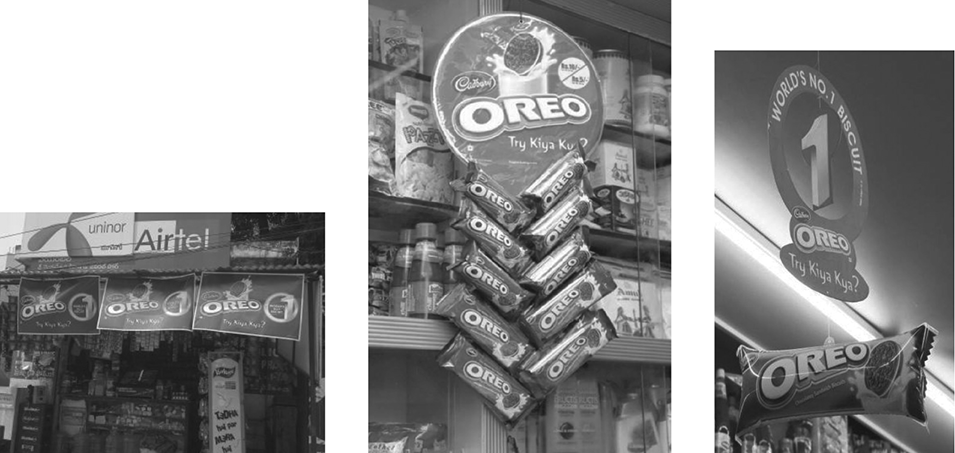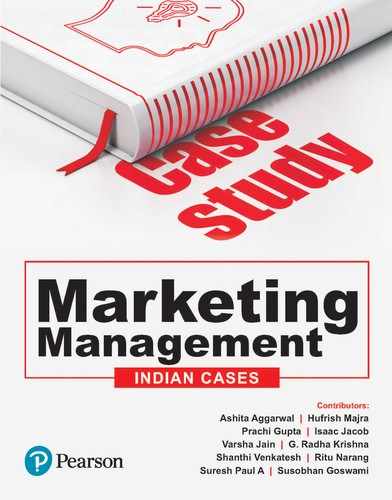CASE 17
Oreo in India – Launching and Establishing A Global Brand in India Using Integrated Marketing Communications Effectively
INTRODUCTION
For most of its 100-year plus existence, Oreo was consistently America’s best loved cookie, but today it is a well-established global brand. Mondelez International moved it into emerging markets quickly learning the rules of success in these hitherto unfamiliar markets, changing and refining the brands strategy and ultimately triumphed in winning over consumers. This case demonstrates how Oreo brand’s successful entry into the Indian market was well orchestrated using the Communication Mix elements such as Advertising, Sales Promotion, Events and experiences and Public Relations to establish the brand during the launch phase and subsequently stabilize and grow the brand in India.
BACKGROUND AND COMPANY PROFILE
The “Oreo Biscuit” was first developed and produced by the National Biscuit Company (today known as Nabisco) in 1912 at its Chelsea Manhattan factory in New York, US. This factory was located on Ninth Avenue between 15th and 16th Streets. Today, this same location of Ninth Avenue is known as “Oreo Way.”
On March 6, 2012, the famous cookie brand, Oreo, celebrated its 100th birthday. From humble beginnings in a Nabisco bakery in New York City, Oreo has grown to become the bestselling cookie brand of the 21st century generating $2 billion in global annual revenues. Currently owned by Mondelez International, Oreo is one of the company’s dozen billion dollar brands. (Source: __https://www.warc.com/content/article/India_Twists,_Licks,_Dunks_with_Oreo/97608)
Until the mid-1990s, Oreo largely focused on the US market – as reflected in one of its popular advertising slogans from the 1980s, “America’s Best Loved Cookie”. But limited growth opportunities in the US Market spurred the company to turn to emerging markets like China and India. Mondelez International, launched Cadbury Oreo in India in March 2011. (Ref Annexure 1)
MARKET BACKGROUND AND BRAND STRATEGY IN INDIA
Mondelez was present in India in the Chocolates, Beverages and Candy categories. The company entered the Rs 17,000 crore, competitive India Biscuit market with their lead brand Oreo in 2011. The Biscuits category was growing at 17% in India (Nielsen Survey, 2010). While the Oreo launch presented opportunities, it also posed great challenges. From being a leader in the Chocolates category in India, Mondelez was now a challenger in the Biscuits category.
The challenge was to launch Oreo and peg it against three Biscuit category titans – Parle (41%), Britannia (26%) and ITC (8%), who dominated the biscuit market with a total of 75% market share. These players had been present in the market for many years and had a strong portfolio of established household brands. And the Biscuit category was a very competitive market - only two brands (Parle-G and Britannia Good Day) in a pool of about 1000 brands had garnered more than a 5% market share. Even established brands like Hide and Seek, Monaco and Bourbon had less than 2% market share. This shows the seemingly insurmountable task that a new brand had to circumvent to establish its credentials in this category in India. (Ref Annexure 2) (Source: Nielsen Survey 2010)
Cream biscuits are primarily consumed by households with children. Cream being the central component and biscuit just the shell, the focus for a brand was obvious and undisputable – Cream! It was also known that consumers did not find any differentiation between brands. Therefore, the key challenge for Oreo was to decide on how to get a firm foothold in a fiercely competitive category ruled by familiar household brand names with firmly entrenched buying and consumption habits.
Oreo was launched in India in March 2011. It entered the market as Cadbury Oreo because Cadbury is a strong brand name in India, and initially focused on generating awareness and rapid trials. The key objectives of the launch were:
- Gain a 1% share of the Biscuit category in the first year.
- Build awareness, 40% trials and 40% repeat purchase in priority markets.
THE MARKETING MIX IMPERATIVES: OREO IN INDIA
The product was fine-tuned to suit the Indian palate and Mondelez leveraged the retail stores reach acquired with the Cadbury acquisition to build distribution.
Oreo launched its traditional chocolate cookie with vanilla cream centre at Rs 5 for a pack of three to drive impulse purchase and trials, Rs 10 for a pack of seven and Rs 20 for a pack of 14 for heavy consumption segment. The cookie design was the same as its international counterpart – a part of the consistent brand imagery of Oreo.
The company maintained the heritage of the two decoratively embossed chocolate cookies filled with sweet vanilla cream to stand out from me-too products and meet customer expectations of having the real Oreo.
FOCUS ON DISTRIBUTION & IN-STORE PRESENCE: LAUNCH PHASE
Early launch focus was on building strong distribution and adequate availability in Traditional Trade & Modern Trade. However, availability with an emphatic presence at Point of Buying was the need of the hour for Oreo to break through the highly cluttered and fiercely competitive Biscuit Category. In Traditional Trade, a host of unique Point of Purchase (POS) devices were developed to ensure Oreo stands out when stocked within the category. And for the first time, POS devices were executed that brought Oreo outside the category into the front-of-store in a Traditional Trade store. Counter-top POS devices ensured the brand stands out and is easily spotted by the shopper.
In Modern Trade also a similar strategy was followed. Emphatic in-category presence combined with clutter breaking out-of-category POS visibility was executed. This virtually created a “Wall of Blue” effect in the trade channel emphasising and enhancing the brands compelling presence. The primary focus during the in-trade launch was on building the presence of brand Oreo and hence no promotions for trade or consumer were executed in the launch phase. All trade investments were focused on improving the on-shelf presence for Oreo.
OREO BRAND ADVERTISING AND COMMUNICATION
Communication and advertising have been consistent across many markets as the core customer and the brand truths remain the same. The company focused on using the “moments of togetherness” proposition for Oreo in India, with television forming the main medium of communication. In addition, other media platforms were tapped as well. Oreo was present in digital media as well with the Oreo Facebook page adding fans at a rapid rate. The company also created an “Oreo Togetherness Bus” which toured 9 cities and brought alive the Oreo togetherness concept with consumers. A similar campaign was also run with Vans in smaller towns. Oreo strategy was to drive point-of-purchase sales with store displays and in-store consumer activations to generate trial and build consumer preference for the brand.
The brand touch points used for communication included packaging, TV (Spots and programme Sponsorships), Radio spots (including radio programme content), Digital website and social networking sites, host of Out-of Home advertising activities such as hoardings, at airports, in transit communication and billboards. Merchandising, POP, sales promotion, retailtainment to build brand trials and ambient marketing was used to create buzz around the brand launch.
COMMUNICATION STRATEGY THAT ADDRESSES THE MOTHER
In the cream biscuit segment, mothers are the buyers and household with kids form a majority of the consumption. The insight that was leveraged was: mums value the opportunity to create simple, delightful moments for the family to be together. There is nothing that warms the mother’s heart more than seeing her kids share a joyous moment, a smile or a hearty laugh with their dad, siblings or grandparents.
ADVERTISING THEME: BRINGING PEOPLE TOGETHER THROUGH THE OREO RITUAL OF ‘TWIST, LICK AND DUNK’-TLD
Rituals play a central role in the lives of Indians, and they follow them with zeal and enthusiasm. Rituals also help in bringing people together. So this created an opportunity for Oreo to bring families together. The Oreo ritual of ‘Twist, Lick and Dunk’ became a platform to connect with people beyond the product, and bring about taste, joyousness and family bonding.
Oreo’s communication message focused on creating:
- A ‘Ritual of Pleasure’ for the child, centred on the joy of consumption.
- A ‘Ritual of Emotion’ for the parent, that sparks these slowed-down moments of togetherness and enhances the bonding between child and parent.
IMPLEMENTING THE BRAND COMMUNICATION STRATEGY
Creating simple, everyday family bonding moments became the trump card of the brand’s creative strategy. Therefore, the big idea was: ‘Oreo’s eating ritual elicits childlike delight and creates family moments of togetherness’.
FATHER-CHILD RELATIONSHIP THE MOST UNIQUE
Unlike the mother, the father spends far lesser time with the kids. So when the father is around, kids want to grab every opportunity they can to spend time with him. Children do this by constantly engaging with the father and bringing him into their world. Fathers, in turn, join in and cherish these delightful poignant moments by becoming childlike themselves and giving in to the kids’ requests.
The Oreo launch TVC captured the nuances of this relationship. The TVC depicted an everyday situation in the home, where Oreo fostered simple family bonding moments through the ‘Twist, Lick, Dunk’ (TLD) ritual that elicited childlike delight.
Oreo twisted, licked and dunked its way into Indian hearts. The communication medium were selected based on their affinity with mothers who were the TG for the communication. (Ref Youtube link: https://www.youtube.com/watch?v=xr2Qkd8ucfQ)
TV CAMPAIGN
Oreo TV campaign was launched in March 2011. The first wave of trials happened based on strong in-store presence of the brand. This trade presence was further amplified with the TV investments scaling-up. The brand had one of the highest SOV (Share of Voice) on-air during this phase in the Biscuit category. The brand’s communication also created disruptive aston (ticker) bands and pushback banners during highly popular Cricket World Cup and IPL series to grab attention and create brand saliency amongst the viewers. This further fuelled the fire at the retail trade level through enhanced brand trials.
OUTDOOR
Billboards, bus wraps, seat backs and handles, backlit boards inside malls and train wraps were swathed in Oreo blue and TLD messaging. Oreo packet-shaped bus shelters strikingly caught the passer-by’s attention. Oreo ‘Twist, Lick and Dunk’ ambient innovation on mobile vans showed the Oreo cookie being dipped into a glass of milk to bring alive the TLD ritual (Ref Annexure 3)
AMBIENT INNOVATION
Oreo ‘Twist Lick Dunk’ Innovation on mobile vans showed the Oreo cookie being dipped in a glass of milk to bring alive the TLD ritual
POINT OF SALE (POS) ACTIVITIES
Best-in-class presence in Modern Trade stores using dispensers, floor shelf units, standees, vinyl’s on walls and spectacular displays. High visibility in Traditional Trade with branded counter-top outers, sleeve hangers, communication windows and inflated pack danglers to aid purchase. (Ref Annexure 4)
SHOPPER ACTIVATION
Oreo engaged thousands of families with fun games and TLD-based sampling in malls and modern trade stores. (Ref Annexure 5)
OREO ‘TOGETHERNESS MOVEMENT’
Oreo initiated a ‘Togetherness Movement’ through activities like TQ Quiz, TQ Survey, Togetherness Pledge and TQ Bus, to encourage parents and kids to spend time together. The Oreo Togetherness Bus visited 9 cities across India. The bus gave families an opportunity to bond over the ‘Twist, Lick and Dunk games’, a cookie corner to sample Oreo, a photo corner to capture fun family moments, and a Togetherness wall where parents and kids could make a pledge to spend more time together. (Ref Annexure 6)
DIGITAL ENGAGEMENT
Activities were shown on the Oreo India website, on Facebook and online TLD games and contests created fun moments for people to engage with Oreo.
BRAND PERFORMANCE AGAINST OBJECTIVES
Brand Share
Oreo’s target 1% share was achieved within the first 6 months of its launch in the market. (Source: Nielsen Survey, 2011) (Ref Annexure 7)
Building Brand Trials and Repeats
Brand trials and repeats exceeded targets for both children and adults within four months of the brand’s launch. (Source: IPSOS Brand Tracking Study, 2011). (Ref Annexure 8)
Brand Awareness Scores
Oreo Brand Awareness beat other cream biscuits brand’s awareness. (Source: IPSOS Brand Tracking Study, 2011). (Ref Annexure 9) and Oreo performed better than norms on brand linkage. (Source: IPSOS Brand Tracking Study, 2011). (Ref Annexure 10)
With a strategy focused on rapid brand awareness and extensive distribution, the Oreo India launch story has been a success so far.
OREO LAUNCH - FACEBOOK RESULTS
Oreo among TOP 30 brands on Facebook in India
Oreo India Facebook Community crossed 45,000 members in just 9 weeks
Within 5 months of the launch, the Oreo India Facebook had 5,00,000 fans
IN CONCLUSION
Oreo has been able to get a very firm foothold in the highly competitive biscuits market in India by creating compelling differentiation at every level - in product offering, in-store in the Traditional and Modern Trade channels, in leveraging a unique consumer insight, in addressing consumers’ desires and in establishing a new ritual. This differentiation was amplified and communicated to the target consumers using a plethora of cherry-picked integrated marketing communications tools and techniques- mass media advertising, consumer contact programmes, radio, bill boards, POS material to generate trials and brand conversion, social media networking sites, creating buzz through ambient media communications, exploiting the brand’s website, Out-of Home media etc. All this has been orchestrated to single-mindedly create differentiation at the consumer level for Oreo brand. Thus making Oreo a part of the consumers’ repertoire in a highly crowded and fiercely competitive biscuit market in India.
In sum: To be different. You have to be seen as different.
ANNEXURE 1: HISTORY OF OREO GLOBALLY


ANNEXURE 2: MARKET SHARE OF BRANDS IN THE BISCUITS CATEGORY. (NIELSEN 2010)

ANNEXURE 3: OUTDOOR (MAY 2011)

ANNEXURE 4: POS ACTIVITIES (MARCH 2011)

counter tops

dispensers

shelf in shelf units

communication windows

Other elements
ANNEXURE 5: SHOPPER ACTIVATION (JUN 2011)

ANNEXURE 6: OREO TOGETHERNESS MOVEMENT (JUNE 2011)

ANNEXURE 7: BRAND SHARE
| Brand Metrics | Year 1 (March 2011 – March 2012) Target | Achieved in June 2011 |
|---|---|---|
| Value share (%) | 1 | 1 |
ANNEXURE 8: BUILD TRIALS AND REPEATS

ANNEXURE 9: BRAND AWARENESS SCORES

ANNEXURE 10: BRAND AWARENESS SCORES

QUESTIONS
- Analyse and discuss the competitive scenario in the Biscuit’s category in 2011. Do a SWOT on the competing brands and Oreo.
- Elaborate on the communications strategy developed for Oreo in India. Do you agree/disagree? Why?
- Discuss the various elements of the Integrated Marketing Communications campaign developed and executed for Oreo launch. Emphasis on the major focus on distribution and In-store presence of Oreo prior to the launch of the TV Campaign?
- According to you what has been the most critical factor(s) that contributed to the brand’s success during the launch phase in India?
- Develop and discuss the next phase of the Brand’s Integrated Marketing Communication programme.
ACKNOWLEDGEMENTS
- Ms Trisha Parekh- Phd student in NITIE for content building and drafting the case study.
- Ms Arthi Basak-Associate Vice President –FCBINTERFACE
